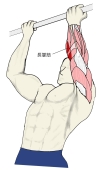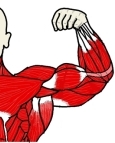長掌筋 (ちょうしょうきん、英:palmaris longus muscle)
・ 概 要 |
・ 作 用 |
・ イラスト掲載サイト |
|
・ イラスト |
・ 神経 / 脈管 |
||
・ 起始 / 停止 |
・ Wikipedia |
![]()




欠如 ) 人種によってことなるようで、日本人で「約 3~8 %」 ( 日本人体解剖学 )
※ 「Wikipedia」にはアジア人で「4.6~26.6%」という数字が見られる。
2頭 ) 「 2頭または2筋の発達もありうる。」 (船戸和也のHP)
その他)「Wikipedia」には以下のような解説文が見られる。詳しくは「Wikipedia」を参照のこと。
・ 上部が腱で、下部に筋線維が集中することがある。
・ 筋線維は中央部に集中し、その上下は腱となることがある。
筋連結 : 尺側手根屈筋、 浅指屈筋、 橈側手根屈筋、 上腕ニ頭筋
触察 : 前腕前面の浅層にある腱で、その腱は前腕の中央を走っているので 容易に確認することができ、
その腱を追っていくと筋腹の一部も触診することが可能。 ⇒ イラスト解説
「骨格筋の形と触察法(太峰閣)」には以下のような解説文が見られる。
「長掌筋の筋腹は紡錘状を呈するが、筋腹の中央部には停止腱が存在し、筋線維の走行方向に着目するならば、放射状の筋である。また、羽状や半羽状を呈する場合もある。」「
・「欠如することがある(3-8%)。この際、手掌腱膜は見られる。筋腹に中間腱を見ることがある。そのほか、起始、停止に異常が多い。」「日本人体解剖学」(南山堂)
⇒ 「Ruber-Kopsch解剖学」の長掌筋の解説ページの引用文
![]()
 |
||||
![]()
【 停 止 】 : 手掌腱膜
![]()
「 手掌腱膜を緊張させ、手を屈曲する。」 ( 日本人体解剖学 )
![]()
・ 神 経 : 正中神経 (C8) ※ C7とT1の両方、またはどちから一方を含む場合がある。
・ 脈 管 : 尺骨動脈の枝
The palmaris longus is a muscle visible as a small tendon located between the flexor carpi radialis and the flexor carpi ulnaris, although it is not always present. It is absent in about 14 percent of the population; however, this number varies greatly in African, Asian, and Native American populations.[1] Absence of the palmaris longus does not have an effect on grip strength.[2]
The palmaris longus muscle can be seen by touching the pads of the fourth finger and thumb and flexing the wrist. The tendon, if present, will be visible in the midline of the anterior wrist.
【Structure】
Palmaris longus is a slender, elongated, spindle shaped muscle, lying on the medial side of the flexor carpi radialis. It is widest in the middle, and narrowest at the proximal and distal attachments.
It arises mainly from the medial epicondyle of the humerus via the common flexor tendon. It also takes origin from the adjacent intermuscular septa and from the antebrachial fascia.
It ends in a slender, flattened tendon, which passes over the upper part of the flexor retinaculum and inserts onto the central part of the flexor retinaculum and lower part of the palmar aponeurosis. Frequently, it sends a tendinous slip to the short muscles of the thumb.
【 語 句 】
・ flexor carpi radialis : 橈側手根屈筋 ・ flexor carpi ulnaris : 尺側手根屈筋 ・ elongate : 引き延ばす ・ spindle shaped : 紡錘形の ・ proximal : 近位の ・ distal : 遠位の ・ medial epicondyle : 内層 ・ humerus :上腕骨 ・ common flexor tendon : 共通の屈筋腱? ・ adjacent : 近隣の ・ intermuscular septa : 筋間中隔 ・ antebrachial fascia : 前腕筋膜 ・ flexor retinaculum : 屈筋支帯 ・ palmar aponeurosis : 手掌腱膜
【 Nerve supply 】
The palmaris longus is supplied by the median nerve.
【 Variation 】
The palmaris longus muscle is a variable muscle. The most common variation is its absence. Several in vivo and in vitro studies have documented the prevalence or absence of the PL tendon in different ethnic groups. Between 5.5 and 24% of Caucasian populations (European and North American) and 4.6 to 26.6% of Asian populations (Chinese, Japanese, Indian, Turkish, Malaysian) have been reported to lack the PL tendon.
There are also variations related to its form. It may be tendinous above and muscular below; or it may be muscular in the center with a tendon above and below; or it may present two muscular bundles with a central tendon; or finally it may consist solely of a tendinous band. The muscle may be double, or missing entirely. Slips of origin from the coronoid process or from the radius have been seen. Partial or complete insertion into the fascia of the forearm, into the tendon of the flexor carpi ulnaris and pisiform bone, into the scaphoid, and into the muscles of the little finger have been observed.
【 語 句 】
・ median nerve : 正中神経 ・ variable : 変化しやすい ・ prevalence : 広く行き渡っていること ・ solely : 単に ・ coronoid process : 鈎状突起 ・ radius : 橈骨 ・ pisiform bone : 豆状骨 ・ scaphoid : 舟状骨
![]()







